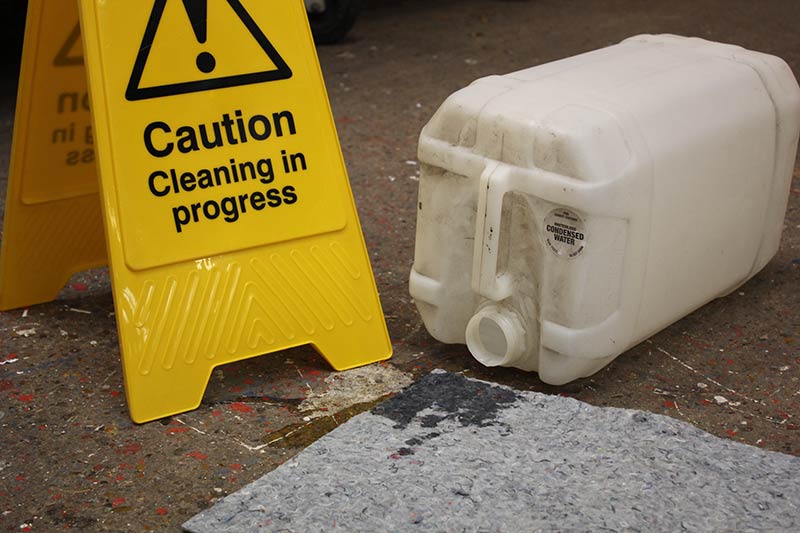To maintain health and safety and meet current UK legislation when a liquid spillage occurs on site it must be dealt with quickly and efficiently. In the industrial and construction sectors, a wide range of liquids are used, such as fuels and lubricants. Petrol and diesel may be used to power equipment like warehouse handling solutions, while oils and hydraulics fluids can help ensure their internal components are protected from contaminants and corrosion and that they are operating at optimum capacity.
An essential resource for any effective operation, these liquids are delivered to sites in bulk orders and stored safely until required. Spills are a potential risk in any environment where liquids are used. Containers can be damaged in transit or accidents can occur while they are being used. It’s understood that whether leaks and spills occur from faulty containment or equipment, or during change intervals and refuelling, they must be dealt with immediately.
Spills present different types of hazards and risks. Within the workplace, spillage can result in slips and falls or damage to products and goods. If the liquids involved are toxic or flammable, they can present an even greater threat to both personnel onsite due to fire and fumes and even the premises itself if the spillage is ignited or contaminated with chemicals.
On a wider scale, if a spillage is allowed to spread and reach a drain or outdoor area, it can negatively impact the environment. Chemicals, oils and fuels should never be allowed to enter water drainage systems and enterprises that allow this to happen can face heavy legal penalties for their negligence.
Fortunately, a wide range of spill control products is available that are designed to deal with incidents on every scale. Read on to understand the best practices for coping with an onsite spill and the spill control options available.
Spill kits
Dedicated spill kits have been created to ensure that onsite teams have all the items they require to tackle different kinds of spills in a single pack. Common items in kits include absorbent cloths, pillows, and pads as well as hazard signs to deploy while working. These kits are compact, light and have handles, making them simple to store and exceptionally portable for reacting rapidly to incidents on site.
Protective platforms and trays
Work floor pallets are designed for spill containments and provide an ideal surface for using and storing lubricants safely. Available in an extensive range of options, they ensure that if leaks and spills occur all fluid is caught and contained before it becomes a hazard.
Absorbent granules
Made from both organic and inorganic materials, absorbent granules can be used to dry up extensive spills inside and outdoors. Designed to be fast-acting, this useful product is perfect for clearing up spills quickly.
Drain coverings
To stop potential leaks, specially designed drain covers are available which can effectively seal off access areas where liquids can enter plumbing and drainage. A wise approach is to cover any drains nearby first before interacting with liquids.
Absorbents
An extensive array of absorbents can be purchased to deal with spills of different sizes and types. Absorbent pillows, pads, and maintenance socks are available that can soak up and safely contain general and specific fluids, from chemical lubricants to oils. Rolls of easy-to-use absorbent cloth are also offered that are ideal for smaller spills and mopping up minor leaks.
Spill depots
To ensure staff onsite can quickly locate the equipment they need to control spills, spill depots have been developed. These stations are clearly marked and boldly coloured with plenty of easy to access storage space where spill kits and absorbents can be kept.
How to handle a spill on site
Finally, when managing spill control there are best practices all companies should establish onsite. Before tackling any spill, appropriate PPE should be adopted. At a minimum, this should include gloves and protective goggles, but depending on the substance involved, masks, coveralls and over boots may be necessary. The first step is to identify the source of the leak or spill and stop it immediately. The area affected by the spill should then be cordoned off, blocking access to prevent risks. If drains are located close by, they should be covered as quickly as possible to stop the liquid from entering any plumbing and drainage systems. If the leak is small, it may be possible to tackle it with absorbent cloths, however, for more serious incidents absorbent granules may be required.
A preventative approach is always best to avoid spills in the first place. Along with ensuring the appropriate number of staff are present to handle large containers, protective policies should be in place to ensure your workforce is fully trained. Soil pallets and other work floor platforms can also be useful to provide a safe and even surface for decanting liquids on site.

